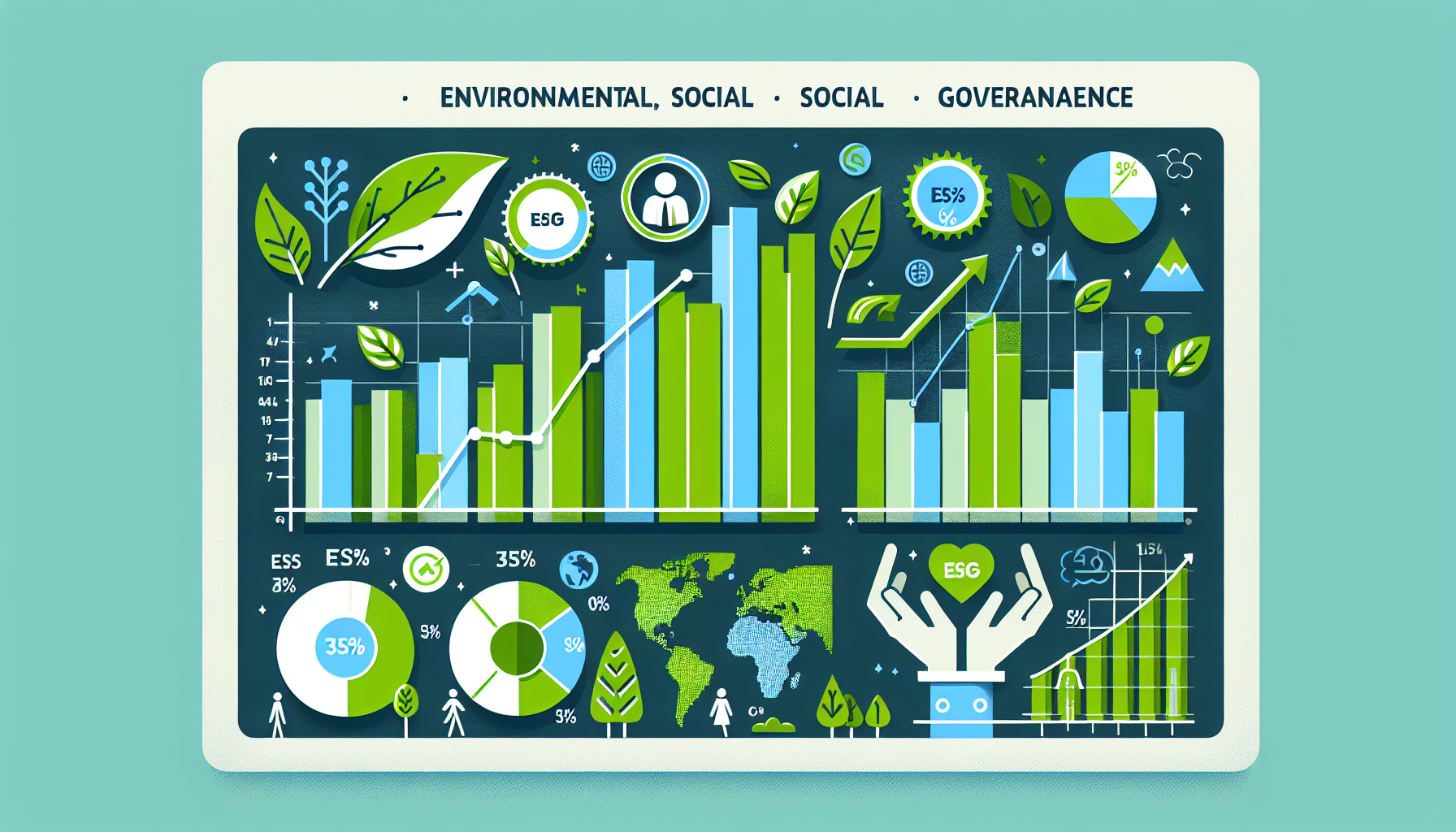Unveiling the insights of citi esg report
Citi ESG reports evaluate a company’s environmental, social, and governance practices, offering transparency that helps stakeholders assess sustainability performance and impact on long-term success.
The citi esg report offers a comprehensive look at sustainability and accountability in modern business practices. Curious about its implications for your industry? Let’s dive deeper.
Understanding the importance of ESG reports
Understanding the importance of ESG reports is crucial for investors and stakeholders alike. These reports provide transparency regarding a company’s operations, focusing on its environmental, social, and governance practices. By evaluating ESG criteria, investors can gauge the long-term sustainability and ethical impact of their investments.
Environmental factors assess how a company performs as a steward of nature. This includes metrics on waste management, energy consumption, and carbon emissions. Understanding these elements helps stakeholders identify potential risks and opportunities related to sustainability.
Social criteria delve into how a company manages relationships with employees, suppliers, customers, and communities. Issues such as labor practices, diversity, and community engagement are critical in evaluating a company’s social responsibility. These aspects are increasingly influencing consumer choices and can enhance brand loyalty.
Finally, governance focuses on the leadership structure and operational practices that drive transparency and ethical decision-making. This includes assessing board diversity, executive compensation, and shareholder rights. A strong governance framework is essential for maintaining investor trust and ensuring compliance with regulations.
Key components of the citi esg report
The citi esg report highlights several key components that are crucial for understanding a company’s sustainability efforts. First, it addresses the environmental impact, detailing how businesses manage resources and mitigate their carbon footprint. Companies often report on energy usage, waste management, and initiatives to reduce greenhouse gas emissions.
Next, the report includes vital information on social responsibility. This segment evaluates how companies engage with their stakeholders, including employees, communities, and customers. Metrics on diversity, labor practices, and community involvement provide insight into a company’s social impact and ethical standing.
Moreover, the governance aspect focuses on the leadership structure of the company. It examines the board’s diversity, executive compensation, and the adherence to ethical standards. Effective governance practices help ensure that companies operate transparently and in the best interest of their stakeholders.
Lastly, the report emphasizes the importance of sustainability policies that guide the company’s long-term strategies. These policies outline the goals and commitments made towards achieving environmental and social objectives, showcasing the company’s dedication to responsible business practices.
How to interpret ESG data effectively
Interpreting ESG data effectively is essential for stakeholders seeking to gauge a company’s sustainability performance. First, it’s crucial to understand the metrics used in these reports. Companies often employ a range of indicators that track their environmental, social, and governance practices, which can vary significantly across industries.
To start, focus on the environmental metrics that often include carbon emissions, energy consumption, and waste management practices. These indicators illustrate how well a company minimizes its ecological footprint. Look for trends over time to assess improvements and to identify any areas that require further attention.
Social metrics can include diversity statistics, employee satisfaction scores, and contributions to community development. Evaluating these numbers helps stakeholders understand how a company supports its workforce and addresses societal responsibilities. Review comparisons to industry standards or peer companies for better context.
Lastly, examine the governance criteria such as board diversity and executive compensation structures. Transparency in governance practices is vital for building trust. Ensure that these practices are aligned with the company’s stated values and sustainability goals. This comprehensive analysis allows for a more nuanced understanding of a company’s commitment to ESG principles.
Trends in sustainability reporting
Trends in sustainability reporting are continually evolving as businesses strive to meet the growing demand for transparency surrounding their environmental, social, and governance practices. One significant trend is the increasing adoption of standardized reporting frameworks. Frameworks such as the Global Reporting Initiative (GRI) and the Sustainability Accounting Standards Board (SASB) provide a structured approach for companies to disclose relevant information, making it easier for stakeholders to compare data.
Another notable trend is the integration of technology in sustainability reporting. Companies are increasingly utilizing data analytics and artificial intelligence to collect, analyze, and report ESG metrics. This technological adoption enhances accuracy and provides real-time insights into sustainability practices.
Stakeholder engagement is also becoming a vital component of sustainability reporting. Companies now recognize the need to involve various stakeholders, including customers and investors, in their reporting processes. This engagement helps in aligning corporate strategies with stakeholder expectations, ultimately improving trust and credibility.
Furthermore, there is a marked shift towards more forward-looking disclosures. Companies are not just reflecting on past performance but are also outlining future sustainability goals and strategies. This proactive approach provides stakeholders with a clearer view of a company’s long-term sustainability journey.
Impact of ESG on corporate performance
The impact of ESG (Environmental, Social, and Governance) factors on corporate performance has become increasingly evident in recent years. Companies that prioritize ESG practices often see a boost in their overall performance metrics. For instance, focusing on environmental sustainability can lead to cost savings through improved energy efficiency and waste reduction.
Social factors are equally important. Companies that foster a positive workplace culture and prioritize diversity tend to have higher employee satisfaction. This often translates into lower turnover rates and increased productivity, enhancing overall company performance. Additionally, businesses engaged in community initiatives can build stronger brand loyalty among consumers.
On the governance side, transparent and ethically sound management practices are essential. Companies with strong governance structures tend to experience better decision-making processes and reduced risks associated with fraud or misconduct. This stability can foster investor trust and improve share prices.
Furthermore, various studies indicate a correlation between strong ESG performance and financial returns. Investors are increasingly looking at ESG metrics as part of their decision-making processes, recognizing that sustainable practices can lead to long-term gains. By integrating ESG considerations into their strategies, companies position themselves favorably for future success.
Regulatory frameworks for ESG disclosures
Regulatory frameworks for ESG disclosures are evolving rapidly as governments and organizations recognize the need for accountability in corporate sustainability practices. These frameworks set guidelines for how companies should report their environmental, social, and governance performance. Such regulations aim to provide transparency, enabling investors and stakeholders to make informed decisions.
One prominent framework is the European Union’s Sustainable Finance Disclosure Regulation (SFDR), which requires financial institutions to disclose how they integrate ESG factors into their investment decisions. This regulation encourages firms to adopt sustainable practices while providing clarity to investors about the sustainability profile of their investments.
Another key player is the Securities and Exchange Commission (SEC) in the United States, which has begun to emphasize the importance of ESG disclosures. The SEC’s proposed rules require publicly traded companies to disclose their climate-related risks and governance processes, ensuring that investors are aware of potential impacts on their financial performance.
Internationally, the International Financial Reporting Standards (IFRS) Foundation has initiated the creation of the International Sustainability Standards Board (ISSB), aiming to develop global sustainability disclosure standards. These efforts are designed to harmonize reporting practices across borders, creating a more consistent and reliable approach to ESG disclosures.
Challenges in ESG reporting
Challenges in ESG reporting are significant and can hinder the effectiveness of sustainability initiatives. One major challenge is the lack of standardization across various reporting frameworks. Companies often struggle to choose the right metrics to report, as different stakeholders may require different types of information. This inconsistency can lead to confusion and reduced comparability between organizations.
Another issue is the complexity of data collection. Gathering accurate and relevant data can be time-consuming and resource-intensive. Companies may face difficulties in tracking their performance across various ESG dimensions, especially smaller firms with fewer resources. Additionally, many companies lack the necessary tools and technology to analyze this data effectively.
There is also the challenge of stakeholder expectations. Investors and consumers are increasingly demanding transparency and accountability, pushing companies to disclose more information than they may be prepared to share. Balancing comprehensive disclosures with the need to protect sensitive information presents a dilemma for many businesses.
Finally, regulatory pressures are mounting. As governments implement stricter regulations, companies must keep up with changing requirements and ensure compliance. This can add another layer of complexity to the ESG reporting process, making it essential for organizations to stay informed and adaptable.
Future of ESG reporting strategies
The future of ESG reporting strategies is poised for significant transformation as businesses adapt to evolving demands from stakeholders and regulatory bodies. One key trend is the integration of advanced technology into reporting processes. Companies are increasingly leveraging data analytics and artificial intelligence to enhance the accuracy and efficiency of their ESG disclosures. This technological adoption allows for real-time monitoring and reporting, providing stakeholders with up-to-date information.
Moreover, the push for standardization across ESG reporting frameworks is expected to gain momentum. As more organizations embrace sustainability practices, the need for consistent reporting guidelines will become critical. Efforts to develop universal standards, such as those initiated by the International Financial Reporting Standards Foundation, aim to harmonize ESG disclosures and facilitate easier comparisons across industries.
Additionally, businesses are likely to place greater emphasis on aligning their ESG strategies with long-term performance goals. This involves not only reporting past performance but also projecting future ESG impacts and initiatives. By setting measurable sustainability targets and publicly committing to them, companies can build trust with investors and consumers.
Finally, stakeholder engagement will become a fundamental aspect of ESG reporting strategies. Companies will need to actively involve their investors, employees, and customers in discussions about sustainability, ensuring that their reporting addresses the interests and concerns of all relevant parties.
Frequently Asked Questions
What is ESG reporting?
ESG reporting involves disclosing data related to a company’s environmental, social, and governance practices. It helps stakeholders assess a company’s sustainability performance.
Why is ESG reporting important for businesses?
ESG reporting is important because it helps companies build transparency and trust with stakeholders, enhances their reputation, and can lead to better investment opportunities.
What are the common challenges in ESG reporting?
Common challenges include lack of standardization, difficulties in data collection, meeting stakeholder expectations, and navigating regulatory pressures.
How can businesses improve their ESG reporting strategies?
Businesses can improve their ESG reporting by adopting advanced technologies, setting measurable sustainability goals, and actively engaging stakeholders in the reporting process.
What role does technology play in ESG reporting?
Technology plays a crucial role in ESG reporting by enabling better data analysis, streamlining reporting processes, and allowing for real-time monitoring of sustainability metrics.
What is the future of ESG reporting?
The future of ESG reporting is likely to involve greater standardization, integration of advanced technologies, and enhanced stakeholder engagement to ensure transparency and accountability.






